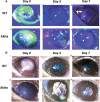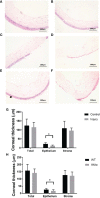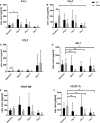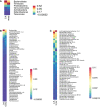The association between altered intestinal microbiome, impaired systemic and ocular surface immunity, and impaired wound healing response after corneal alkaline-chemical injury in diabetic mice
- PMID: 36798135
- PMCID: PMC9927643
- DOI: 10.3389/fimmu.2023.1063069
The association between altered intestinal microbiome, impaired systemic and ocular surface immunity, and impaired wound healing response after corneal alkaline-chemical injury in diabetic mice
Abstract
Purpose: We aim to investigate the effect of sustained hyperglycemia on corneal epithelial wound healing, ocular surface and systemic immune response, and microbiome indices in diabetic mice compared to controls after alkaline chemical injury of the eye.
Methods: Corneal alkaline injury was induced in the right eye of Ins2Akita (Akita) mice and wild-type mice. The groups were observed at baseline and subsequently days 0, 3, and 7 after injury. Corneal re-epithelialization was observed under slit lamp with fluorescein staining using a cobalt blue light filter. Enucleated cornea specimens were compared at baseline and after injury for changes in cornea thickness under hematoxylin and eosin staining. Tear cytokine and growth factor levels were measured using protein microarray assay and compared between groups and time points. Flow cytometry was conducted on peripheral blood and ocular surface samples to determine CD3+CD4+ cell count. Fecal samples were collected, and gut microbiota composition and diversity pattern were measured using shotgun sequencing.
Results: Akita mice had significantly delayed corneal wound healing compared to controls. This was associated with a reduction in tear levels of vascular endothelial growth factor A, angiopoietin 2, and insulin growth factor 1 on days 0, 3, and 7 after injury. Furthermore, there was a distinct lack of upregulation of peripheral blood and ocular surface CD3+CD4+ cell counts in response to injury in Akita mice compared to controls. This was associated with a reduction in intestinal microbiome diversity indices in Akita mice compared to controls after injury. Specifically, there was a lower abundance of Firmicutes bacterium M10-2 in Akita mice compared to controls after injury.
Conclusion: In diabetic mice, impaired cornea wound healing was associated with an inability to mount systemic and local immune response to ocular chemical injury. Baseline and post-injury differences in intestinal microbial diversity and abundance patterns between diabetic mice and controls may potentially play a role in this altered response.
Keywords: T-cell mediated immunity; alkaline chemical injury; corneal wound healing; diabetes; intestinal microbiome; ocular surface.
Copyright © 2023 Bu, Shih, Wong, Kwok, Lo, Chan, Ng, Chan, Jhanji and Tong.
Conflict of interest statement
The authors declare that the research was conducted in the absence of any commercial or financial relationships that could be construed as a potential conflict of interest.
Figures









Similar articles
-
Experimental modeling of cornea wound healing in diabetes: clinical applications and beyond.BMJ Open Diabetes Res Care. 2019 Nov 27;7(1):e000779. doi: 10.1136/bmjdrc-2019-000779. eCollection 2019. BMJ Open Diabetes Res Care. 2019. PMID: 31803484 Free PMC article. Review.
-
Resolvin D1 promotes corneal epithelial wound healing and restoration of mechanical sensation in diabetic mice.Mol Vis. 2018 Apr 1;24:274-285. eCollection 2018. Mol Vis. 2018. PMID: 29643724 Free PMC article.
-
Insulin eye drops improve corneal wound healing in STZ-induced diabetic mice by regulating corneal inflammation and neuropeptide release.BMC Ophthalmol. 2024 Apr 9;24(1):155. doi: 10.1186/s12886-024-03436-3. BMC Ophthalmol. 2024. PMID: 38594682 Free PMC article.
-
Corneal complications in streptozocin-induced type I diabetic rats.Invest Ophthalmol Vis Sci. 2011 Aug 22;52(9):6589-96. doi: 10.1167/iovs.11-7709. Invest Ophthalmol Vis Sci. 2011. PMID: 21715347 Free PMC article.
-
Human platelet lysate delivered via an ocular wound chamber for the treatment of corneal epithelial injuries.Exp Eye Res. 2021 May;206:108493. doi: 10.1016/j.exer.2021.108493. Epub 2021 Feb 14. Exp Eye Res. 2021. PMID: 33596441 Review.
Cited by
-
The Role of Insulin-like Growth Factor (IGF) System in the Corneal Epithelium Homeostasis-From Limbal Epithelial Stem Cells to Therapeutic Applications.Biology (Basel). 2024 Feb 25;13(3):144. doi: 10.3390/biology13030144. Biology (Basel). 2024. PMID: 38534414 Free PMC article. Review.
-
Effects of Topical 1,25 and 24,25 Vitamin D on Diabetic, Vitamin D Deficient and Vitamin D Receptor Knockout Mouse Corneal Wound Healing.Biomolecules. 2023 Jul 1;13(7):1065. doi: 10.3390/biom13071065. Biomolecules. 2023. PMID: 37509101 Free PMC article.
-
Progranulin Facilitates Corneal Repair Through Dual Mechanisms of Inflammation Suppression and Regeneration Promotion.Inflammation. 2024 Oct;47(5):1648-1666. doi: 10.1007/s10753-024-01999-3. Epub 2024 Mar 9. Inflammation. 2024. PMID: 38460093
References
MeSH terms
Substances
LinkOut - more resources
Full Text Sources
Medical
Molecular Biology Databases
Research Materials

